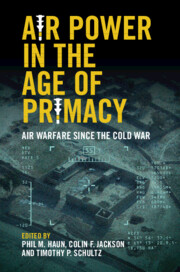Book contents
- Air Power in the Age of Primacy
- Air Power in the Age of Primacy
- Copyright page
- Contents
- Figures
- Tables
- Contributors
- Preface
- Abbreviations
- 1 Air Power in the Age of Primacy
- 2 Remote Warfare: A New Architecture of Air Power
- 3 Deliberate Force: Ambivalent Success
- 4 Hoping for Victory: Coercive Air Power and NATO’s Strategy in Kosovo
- 5 Operation Enduring Freedom
- 6 The Result Is Never Final: Operation Iraqi Freedom
- 7 Israeli Air Force Effectiveness during the Second Lebanon War (2006)
- 8 Libya 2011: Hollow Victory in Low-Cost Air War
- 9 Coercing a Chaos State: The Saudi-Led Air War in Yemen
- 10 Russia’s Air War Win in Syria
- 11 Air Power in the Battle of Mosul
- 12 Retrospect and Prospect: Air Power in the Age of Primacy and Beyond
- Index
9 - Coercing a Chaos State: The Saudi-Led Air War in Yemen
Published online by Cambridge University Press: 16 December 2021
- Air Power in the Age of Primacy
- Air Power in the Age of Primacy
- Copyright page
- Contents
- Figures
- Tables
- Contributors
- Preface
- Abbreviations
- 1 Air Power in the Age of Primacy
- 2 Remote Warfare: A New Architecture of Air Power
- 3 Deliberate Force: Ambivalent Success
- 4 Hoping for Victory: Coercive Air Power and NATO’s Strategy in Kosovo
- 5 Operation Enduring Freedom
- 6 The Result Is Never Final: Operation Iraqi Freedom
- 7 Israeli Air Force Effectiveness during the Second Lebanon War (2006)
- 8 Libya 2011: Hollow Victory in Low-Cost Air War
- 9 Coercing a Chaos State: The Saudi-Led Air War in Yemen
- 10 Russia’s Air War Win in Syria
- 11 Air Power in the Battle of Mosul
- 12 Retrospect and Prospect: Air Power in the Age of Primacy and Beyond
- Index
Summary
The Saudi-led intervention in Yemen is a valuable case study in the coercive use of air power. Saudi Arabia’s bombing campaign demonstrates the danger of employing a punishment approach against a subnational actor in a multi-sided internal conflict. Strategies of collective punishment, blockade, and decapitation have all malfunctioned against a stubborn and resilient Houthi adversary. The early audit from Yemen endorses a denial strategy, supports the growing orthodoxy that air attack is most effectively applied in support of ground forces, and offers insight on the relative utility of interdiction and close air support for that purpose. The Saudi-led coalition’s performance also underscores how difficult it is to achieve positive objectives with proxy warfare, regardless of air support. This chapter dissects the campaign, assesses its effectiveness, and draws lessons about air power’s ability to influence the outcome of similar complex civil war scenarios elsewhere.
Keywords
- Type
- Chapter
- Information
- Air Power in the Age of PrimacyAir Warfare since the Cold War, pp. 201 - 228Publisher: Cambridge University PressPrint publication year: 2021

